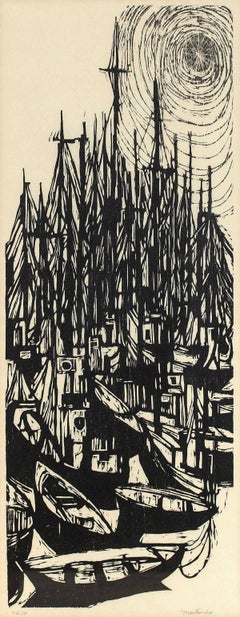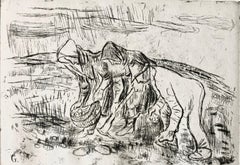Want more images or videos?
Request additional images or videos from the seller
1 of 8
Joseph DomjanBird & Young1956
1956
$1,200List Price
About the Item
- Creator:Joseph Domjan (1907 - 1992, Hungarian)
- Creation Year:1956
- Dimensions:Height: 21 in (53.34 cm)Width: 16.25 in (41.28 cm)
- Medium:
- Period:
- Condition:Minor wear and tear.
- Gallery Location:Surfside, FL
- Reference Number:1stDibs: LU38210989002
About the Seller
4.9
Platinum Seller
Premium sellers with a 4.7+ rating and 24-hour response times
Established in 1995
1stDibs seller since 2014
1,837 sales on 1stDibs
Typical response time: 1 hour
Authenticity Guarantee
In the unlikely event there’s an issue with an item’s authenticity, contact us within 1 year for a full refund. DetailsMoney-Back Guarantee
If your item is not as described, is damaged in transit, or does not arrive, contact us within 7 days for a full refund. Details24-Hour Cancellation
You have a 24-hour grace period in which to reconsider your purchase, with no questions asked.Vetted Professional Sellers
Our world-class sellers must adhere to strict standards for service and quality, maintaining the integrity of our listings.Price-Match Guarantee
If you find that a seller listed the same item for a lower price elsewhere, we’ll match it.Trusted Global Delivery
Our best-in-class carrier network provides specialized shipping options worldwide, including custom delivery.You May Also Like
Festival Procession Of A Daimyo - Original Woodblock Print
Located in Soquel, CA
Procession Of A Daimyo - Original Woodblock Print
Original woodblock print depicting the procession of a Daimyo. Ten Japanese soldiers are seen as they aid in transporting the Daimy...
Category
Late 18th Century Edo Figurative Prints
Materials
Ink, Wood Panel, Rice Paper
$720 Sale Price
20% Off
H 9 in W 18 in D 0.5 in
The Virtues 'Politeness', Limited Edition 'Cherry Blossom' Landscape
By Damien Hirst
Located in New York, NY
The contemporary pop art cherry blossom landscape ‘Politeness' is one of the eight from the iconic ‘Virtues’ series by Damien Hirst, the laminated giclée print on aluminum panel was ...
Category
2010s Contemporary Landscape Prints
Materials
Panel, Giclée
$39,000
H 55.5 in W 45.8 in D 2 in
Invader Rubik Camouflage NVDR1-2 Giclée print on aluminium panel Signed
By Invader
Located in Draper, UT
Invader’s Rubik Camouflage print is emblematic of the artist’s career as an urban disruptor. For decades he has raided cities around the world with his p...
Category
2010s Landscape Prints
Materials
Metal
$25,000
H 39.38 in W 39.38 in D 0.4 in
Invader Rubik Shot Red Marilyn NVDR1-4 Giclée print on aluminium panel Signed
By Invader
Located in Draper, UT
Rubik Shot Red Marilyn derives from Invader’s series ‘Rubik Master Pieces’, in which he manipulates Rubik's Cubes to reproduce major works in the history of art as three-dimensional ...
Category
2010s Landscape Prints
Materials
Metal
$25,000
H 39.38 in W 39.38 in D 0.4 in
Autumn Blues - Sydell Lewis - Digital Pigment Prints
Located in Carmel, CA
** Larger prints are available for purchase. Please feel free to contact us if you're interested.
Enchanted by the intricate symphony of nature's rhythms, the alluring dance of urba...
Category
2010s Contemporary Abstract Prints
Materials
Panel, Pigment
Pink is The Key - Sydell Lewis - Digital Pigment Prints
Located in Carmel, CA
** Larger prints are available for purchase. Please feel free to contact us if you're interested.
Enchanted by the intricate symphony of nature's rhythms, the alluring dance of urba...
Category
2010s Contemporary Abstract Prints
Materials
Panel, Pigment
$750
H 23 in W 17 in D 0.02 in
Painting Nature Two - Sydell Lewis - Digital Pigment Prints
Located in Carmel, CA
** Larger prints are available for purchase. Please feel free to contact us if you're interested.
Enchanted by the intricate symphony of nature's rhythms, the alluring dance of urba...
Category
2010s Contemporary Abstract Prints
Materials
Panel, Pigment
$600
H 15 in W 15 in D 0.02 in
Sanctuary - Sydell Lewis - Digital Pigment Prints
Located in Carmel, CA
** Larger prints are available for purchase. Please feel free to contact us if you're interested.
Enchanted by the intricate symphony of nature's rhythms, the alluring dance of urba...
Category
2010s Contemporary Abstract Prints
Materials
Panel, Pigment
Luminosity - Sydell Lewis - Digital Pigment Prints
Located in Carmel, CA
** Larger prints are available for purchase. Please feel free to contact us if you're interested.
Enchanted by the intricate symphony of nature's rhythms, the alluring dance of urba...
Category
2010s Contemporary Abstract Prints
Materials
Panel, Pigment
Watch Out - Sydell Lewis - Digital Pigment Prints
Located in Carmel, CA
** Larger prints are available for purchase. Please feel free to contact us if you're interested.
Enchanted by the intricate symphony of nature's rhythms, the alluring dance of urba...
Category
2010s Contemporary Abstract Prints
Materials
Panel, Pigment
More From This Seller
View AllBird & Young
By Joseph Domjan
Located in Surfside, FL
Born in Budapest in 1907, he had a humble upbringing and a passion for the arts. Shortly after the Hungarian Revolution broke out in 1956, Domján was invited to showcase his work in ...
Category
20th Century Landscape Prints
Materials
Mixed Media, Wood Panel
Violets
By Joseph Domjan
Located in Surfside, FL
Born in Budapest in 1907, he had a humble upbringing and a passion for the arts. Shortly after the Hungarian Revolution broke out in 1956, Domján was invited to showcase his work in ...
Category
20th Century Landscape Prints
Materials
Wood, Mixed Media, Woodcut
1966 Woodcut "Fleet" Modernist Print
By Roger Martin
Located in Surfside, FL
Genre: Modern
Subject: Landscape
Medium: Print, Woodcut
Surface: Paper
Dimensions w/Frame: 31" x 15 1/2"
Roger was born in the Addison Gilbert Hospital in Gloucester, MA, the son of Capt. Roger Martin and Ellie Emilia Oker, in 1925. His father was born in Rockport, of Portuguese heritage, and his mother was born in Finland. He graduated from Rockport Highschool in 1942. While in high school Roger prepared lobsters for tourists at the Roy Moore Lobster Company on Bearskin Neck and sang and played harmonica with Tony Torissi’s hillbilly band.
Roger enlisted in the U.S. Coast Guard in 1942 and mustered out in 1946, ending his military career as a member of the USCG canine corps only two weeks from going to the Pacific with a Marine detachment. After having lived on both coasts (Manhattan and Los Angeles) he returned to his home town from the West Coast, vowing to never leave again, and he hasn’t. When he returned to Cape Ann he entered the School of the Museum of Fine Arts in Boston where he majored in book design and illustration, graduating with honors.
He illustrated a number of textbooks for D.C. Heath, Beacon Press, and other Boston publishers, as well as provided illustrations for the New York Sunday Times, the New Yorker magazine, the Atlantic Monthly magazine, and a book for the United Church of Christ.
Roger also designed, carved and gold-leafed pipe shades for a number of C. B. Fisk pipe organs, builders of tracker action pipe organs, including those at Harvard and Stanford Universities.
He began his teaching career in Rockport, teaching elementary grade art, following that with four years teaching at the New England School of Art in Boston. Roger became a founding faculty member of the Montserrat College of Art in Beverly, MA, where he taught for twenty years, retiring to make paintings. He was also elected Rockport’s Poet Laureate in the 1990s and in addition wrote and published three books about Rockport.
Roger Martin has exhibited his work throughout New England and beyond. He has shown his work in Portland, ME; New York City; Andover’s Addison Gallery; the Boston ICA; galleries on Newbury Street in Boston; the Rockport Art Association; the Cape Ann Historical Museum (where he is part of the permanent collection); and many others. His work is represented in many private collections, including those of John...
Category
1960s Modern Landscape Prints
Materials
Woodcut
Farmers Gardening Etching, (After Vincent Van Gogh) Famed Children's Book Author
By Tibor Gergely
Located in Surfside, FL
Medium: Etching
Surface: paper
Country: United States
signed in plate with initial G.
Black and white illustration of a landscape with farmhouse (old barn).
TIBOR GERGELY
Budapes...
Category
Mid-20th Century American Modern Landscape Prints
Materials
Etching
Vintage Art Etching Farm with Cow and Farmer, Famed Children's Book Illustrator
By Tibor Gergely
Located in Surfside, FL
Medium: etching
Surface: paper
Country: United States
Signed in plate with initial G.
Black and white illustration of a landscape with farmhouse (old barn).
TIBOR GERGELY
Budapes...
Category
Mid-20th Century American Modern Landscape Prints
Materials
Etching
Large American Modern Stonehenge Landscape Aquatint Etching Philip Pearlstein
By Philip Pearlstein
Located in Surfside, FL
Philip Pearlstein (American, 1924-2022)
Stonehenge Landscape Sugar Lift Aquatint Etching with Roulette on Rives BFK Paper, 1979
Series: Ruins and Landscapes
Printer: Orlando Condesso
Printer: Nancy Brokopp
Medium: Sugar-lift aquatint with roulette
Philip Pearlstein is an influential American painter best known for Modernist Realism nudes. Cited by critics as the preeminent figure painter of the 1960s to 2000s, he led a revival in realist art. He is a Distinguished Professor Emeritus with paintings in the collections of over 70 public art museums.
Philip M. Pearlstein was born on May 24, 1924 in Pittsburgh, PA. He attended Saturday morning classes at Pittsburgh's Carnegie Museum of Art. In 1942, at the age of 18, two of his paintings won a national competition sponsored by Scholastic Magazine, and were reproduced in color in Life magazine. In 1942, he enrolled at Carnegie Institute of Technology's art school, in Pittsburgh, where he painted two portraits of his parents now held by the Carnegie Museum of Art, but after one year he was drafted by the US Army to serve during World War II. He was initially assigned to the Training Aids Unit at Camp Blanding, Florida, where he produced charts, weapon assembly diagrams and signs. In this role, he learned printmaking and the screenprinting process, and subsequently was stationed in Italy making road signs. While in Italy, he took in as much renaissance art as was accessible in Rome, Florence, Venice and Milan, and also produced numerous drawings depicting life in the Army.
In 1946, sponsored by the GI Bill, he returned to Carnegie Institute, and first met Andy Warhol, who was attracted to Pearlstein because of his notoriety in the school, having been featured in Life magazine. During the summer of 1947, the three rented a barn as a summer studio. Immediately after graduating in June 1949 with a BFA, Pearlstein and Warhol moved to New York City, at first sharing an eighth-floor walkup tenement apartment on St. Mark's Place at Avenue A. He was eventually hired by Czech designer Ladislav Sutnar, mainly doing industrial catalog...
Category
1970s American Realist Landscape Prints
Materials
Paper, Aquatint

